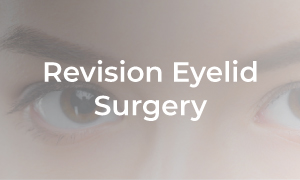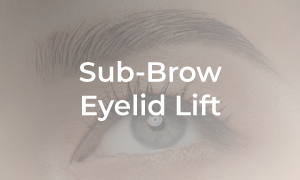Revision Eyelid Surgery
Revision Eyelid Surgery
The anatomy of the eyelid is complex. Eyelid surgery (upper blepharoplasty including double eyelid surgery) demands fine surgical skills and attention to details. Proper pre-operative assessment, precise measurements and planning, gentle tissue handling during surgery, meticulous surgical technique, and correct post-operative care are required to achieve satisfactory results. Other important consideration is that different individuals may have different eyelid anatomy. Each patient may also exhibit different tissue responses to surgery. All of these factors can affect the outcome and results of the eyelid surgery.
Unsatisfactory results after eyelid surgery include excessive scarring, obvious asymmetry, eyelid crease that is too high or too deep, presence of multiple creases, eyelid crease that is too faint, pretarsal fullness, sunken eyelid, and post-operative ptosis. Revision eyelid surgery is done to correct these unsatisfactory results from the previous eyelid surgery. However, it is important to note that there is a possibility that these unfavourable conditions may improve with time. Therefore, it is usually advisable to wait at least 6-12 months after the previous surgery before deciding whether to undergo revision eyelid surgery to correct these problems.
Each revision eyelid surgery is unique. It is crucial to assess and plan each individual case carefully. Good and open discussion between the patient and the surgeon is essential to ensure a good understanding regarding treatment options and the anticipated outcome.
Preparation
-
-
-
Inform the doctor of any pre-existing medical conditions and drug allergy. All medical conditions must be treated and stabilized before surgery.
-
Stop smoking at least one week before surgery. Smoking is harmful to wound healing and increases the risks of other post-operation complications.
-
Stop the following medications and supplements from one week before surgery until one week after surgery.
-
All supplements containing vitamin E, ginseng, ginkgo, garlic, fish oil, and other ingredients that increase bleeding during the procedure. Other supplements, traditional medicine, and herbs, in which ingredients are unknown, have to stop as well.
-
Medicine that increases bleeding during the procedure such as aspirin, NSAIDs, and warfarin. However, you may need to consult your physician who prescribed the medication before you stop them.
-
-
On the day of surgery, wear simple and comfortable clothing and do not wear any makeup. Do not wear any jewelry and metal objects on the face and body.
-
Bring a pair of sunglasses on the day of surgery for use after surgery.
-
Don’t wear contact lenses on the day of surgery.
-
-
Surgery
Duration: Variable, usually 2-3 hours
Anaesthesia: Local anaesthesia
Hospitalization: Not required.
Recovery*: Back to work in 7 days, light exercise after 7 days, heavy exercise after 3-4 weeks. * The actual speed of recovery may vary from person to person.
Surgery Technique: An incision is made on the upper eyelid skin, usually using the previous incision. The exact surgical technique varies, depending on the abnormality to be corrected.
Post-operative Care**
-
-
-
What to expect: Swelling usually peaks on the second to third day after surgery and will gradually subside after that. Post-operative pain is usually minimal.
-
General care:
-
Apply cold pack in the first 3 days and then warm pack in the following 3 days. Elevate the head during sleep to reduce swelling.
-
Avoid smoking for at least one month. Smoking increases the risk of wound complications.
-
Use sunglasses for protection when going outdoors.
-
Good rest and adequate sleep are helpful for a speedy recovery.
-
Be relaxed and calm. Contact the clinic if there are any queries.
-
Don’t use contact lenses for at least 1-2 weeks.
-
-
Medicine: Finish the oral antibiotics as prescribed. Take the painkiller when necessary.
-
Wound care: Clean the wound with a clean cotton tip soaked with sterile water/saline. Apply antibiotic ointment. No wound dressings are required.
-
Physical activity: Avoid heavy physical activities and exercises for at least one month.
-
Follow-up: Come back one week after surgery for suture removal and review.
-
Emergency: If there is heavy bleeding, a rapid increase in swelling or severe pain, contact the clinic/doctor for advice immediately.
-
-
** The instructions in this list are only for general guidance. If you have any specific queries or concerns during the post-operative recovery, please contact the clinic for further advice.








